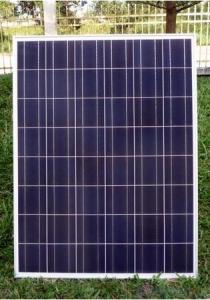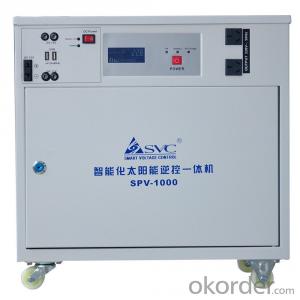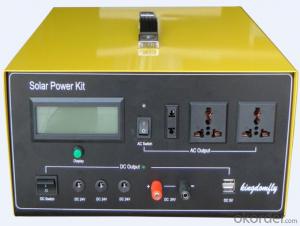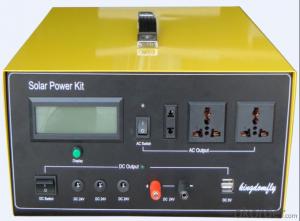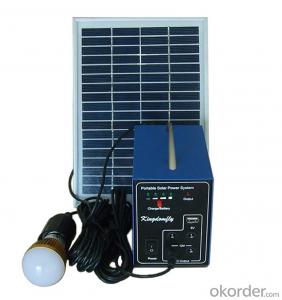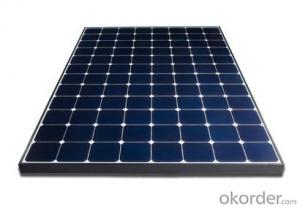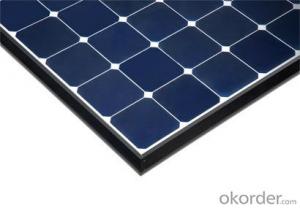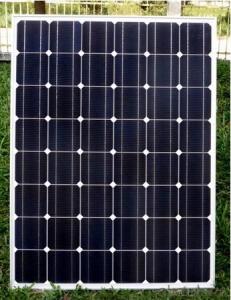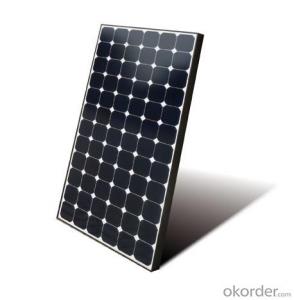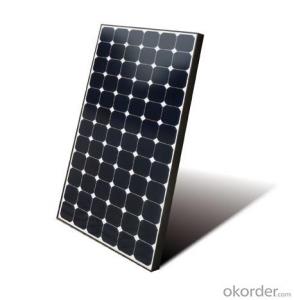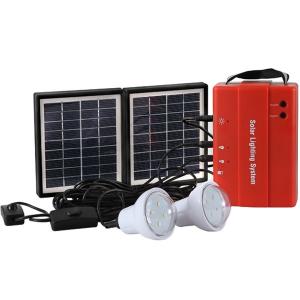Solar Energy Systems Blaine CNBM On Grid System 20000W with Certificate UL TUV CE
- Loading Port:
- Shanghai
- Payment Terms:
- TT OR LC
- Min Order Qty:
- 1000 watt
- Supply Capability:
- 1000 watt/month
OKorder Service Pledge
OKorder Financial Service
You Might Also Like
Specification
CNBM On Grid System 20000W with Certificate UL TUV CE
Product description
They range from small residential and commercial rooftop systems to large utility-scale solar power stations. Unlike stand-alone power systems, a grid-connected system rarely includes an integrated battery solution, as they are still very expensive. When conditions are right, the grid-connected PV system supplies the excess power, beyond consumption by the connected load, to the utility grid.
Connection of the photovoltaic power system can be done only through an interconnection agreement between the consumer and the utility company. The agreement details the various safety standards to be followed during the connection.[4]
A photovoltaic (in short PV) module is a packaged, connected assembly of typically 6×10 solar cells. Solar Photovoltaic panels constitute the solar array of a photovoltaic system that generates and supplies solar electricity in commercial and residential applications. Each module is rated by its DC output power under standard test conditions, and typically ranges from 100 to 365 watts. The efficiency of a module determines the area of a module given the same rated output – an 8% efficient 230 watt module will have twice the area of a 16% efficient 230 watt module. There are a few commercially available solar panels available that exceed 22% efficiency[1] and reportedly also exceeding 24%.[2][3] A single solar module can produce only a limited amount of power; most installations contain multiple modules. A photovoltaic system typically includes a panel or an array of solar modules, a solar inverter, and sometimes a battery and/or solar tracker and interconnection wiring.
The price of solar power, together with batteries for storage, has continued to fall so that in many countries it is cheaper than ordinary fossil fuel electricity from the grid (there is "grid parity").[4]
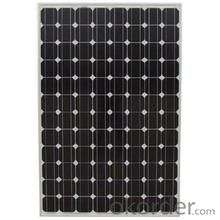
Application
Industrial
Commercial
Residential
Feature
Residential, grid-connected rooftop systems which have a capacity more than 10 kilowatts can meet the load of most consumers.[2] They can feed excess power to the grid where it is consumed by other users. The feedback is done through a meter to monitor power transferred. Photovoltaic wattage may be less than average consumption, in which case the consumer will continue to purchase grid energy, but a lesser amount than previously. If photovoltaic wattage substantially exceeds average consumption, the energy produced by the panels will be much in excess of the demand. In this case, the excess power can yield revenue by selling it to the grid. Depending on their agreement with their local grid energy company, the consumer only needs to pay the cost of electricity consumed less the value of electricity generated. This will be a negative number if more electricity is generated than consumed.[3] Additionally, in some cases, cash incentives are paid from the grid operator to the consumer.
Packaging
With carton and box
- Q: Can solar energy systems be used in areas with limited access to solar energy consultants?
- Yes, solar energy systems can still be used in areas with limited access to solar energy consultants. While it may be challenging to have professional assistance, there are resources available online, guides, and tutorials that can help individuals and communities in these areas understand and set up solar energy systems. Additionally, some companies offer remote consultations and support services, making it possible to overcome the limitations of physical access to solar energy consultants.
- Q: Can a solar energy system be installed in an area with a high bird population?
- Indeed, it is possible to install a solar energy system in an area abundant with birds. However, it is necessary to take certain precautions in order to minimize any potential risks or problems. Birds may be attracted to the solar panels and may perch on them or build nests. As a result, there is a possibility of bird droppings and debris accumulating on the panels, which can diminish their efficiency. To address these risks, there are several measures that can be taken. One option is to incorporate bird deterrents, such as spikes or netting, around the solar panels to dissuade birds from landing or nesting on them. It is important, though, to design these deterrents in a manner that does not block the sunlight required for the panels to produce electricity. Regular maintenance and cleaning of the solar panels can also contribute to their optimal performance. This entails removing any bird droppings, nests, or other debris that may accumulate over time. By keeping the panels clean, their efficiency can be maintained, and potential damage can be minimized. Furthermore, the selection of a suitable location for the solar energy system installation is essential. Placing the panels away from trees or structures that may entice birds to nest can help reduce the likelihood of bird-related issues. In summary, with proper planning, installation, and maintenance, it is feasible to successfully implement a solar energy system in an area teeming with birds while minimizing any potential negative impacts on its functionality.
- Q: How long do solar batteries last?
- Solar batteries, also known as deep-cycle batteries, typically have a lifespan of 5 to 15 years. However, this can vary depending on factors such as usage patterns, maintenance, and the quality of the battery. Regular maintenance and proper usage can significantly extend the lifespan of solar batteries.
- Q: How does the cost of solar panels vary based on the manufacturer?
- The cost of solar panels can vary significantly based on the manufacturer. There are several factors that contribute to the price differences among manufacturers. Firstly, the quality and efficiency of the solar panels can vary between manufacturers. Some manufacturers invest heavily in research and development to improve the efficiency of their panels, resulting in higher-priced but more efficient products. These panels can generate more electricity per square meter, ultimately providing better value for money in the long run. Secondly, the reputation and brand recognition of a manufacturer can impact the cost of their solar panels. Well-established manufacturers with a strong track record of producing reliable and durable panels tend to have higher prices. This is because their products are often perceived as more trustworthy and are backed by extensive warranties and customer support. Thirdly, the manufacturing scale and volume can influence the cost. Larger manufacturers often benefit from economies of scale, allowing them to produce solar panels at a lower cost per unit. They can negotiate better terms with suppliers, have access to advanced production technologies, and optimize their operations more efficiently. These cost savings can be passed on to consumers, resulting in more competitive prices. Lastly, the country of origin can affect the cost of solar panels. Manufacturing costs can vary significantly depending on the labor and production costs of different regions. Panels manufactured in countries with lower labor costs may have a lower price tag compared to those made in countries with higher labor costs. It is important to note that while cost is a crucial factor, it should not be the sole consideration when choosing solar panels. Other aspects such as warranty, durability, efficiency, and after-sales support should also be taken into account.
- Q: How does the presence of birds or other wildlife affect the performance of solar panels?
- The presence of birds or other wildlife can potentially affect the performance of solar panels in several ways. One of the main concerns is the possibility of bird droppings on the surface of the solar panels. Bird droppings can create a layer of dirt and debris, reducing the amount of sunlight that reaches the solar cells. This can lead to a decrease in the efficiency of the panels and a decline in their overall performance. Another issue is the risk of bird nests or other wildlife habitats being built near or on the solar panel systems. These nests can obstruct the sunlight from reaching the panels, causing a drop in energy production. Additionally, nests can potentially damage the panels or their mounting structures if they are built in close proximity. Furthermore, larger birds like raptors or pigeons may occasionally perch on the solar panels, causing physical damage to the panels or the wiring. This can lead to malfunctions or reduced electrical output. To mitigate these potential issues, there are several solutions available. One common approach is the use of deterrents such as bird spikes, netting, or scare devices to prevent birds from landing or nesting on the panels. Regular cleaning and maintenance of the panels are also important to remove any bird droppings or debris that may accumulate. Additionally, designing solar panel systems with bird-friendly features in mind can help minimize the impact on wildlife. For example, incorporating gaps or spaces between panels can discourage birds from nesting, while still allowing sufficient airflow for cooling. In conclusion, while the presence of birds or other wildlife can pose challenges for solar panels, implementing preventive measures and maintenance practices can help ensure optimal performance and longevity of the system.
- Q: Can solar energy systems be used for outdoor recreational activities?
- Yes, solar energy systems can definitely be used for outdoor recreational activities. Solar panels can be installed on rooftops, RVs, boats, and other outdoor structures to generate electricity. This renewable energy source can power various devices and equipment used during recreational activities such as camping, hiking, and boating. Solar energy systems provide a sustainable and environmentally friendly way to enjoy outdoor activities without relying on traditional power sources.
- Q: Can solar energy systems be used in powering street cameras or surveillance systems?
- Street cameras and surveillance systems can indeed be powered by solar energy systems. Solar energy is a reliable and independent source of power that is sustainable and renewable. To utilize solar energy, one can install solar panels on rooftops or mount them on poles near the cameras. These panels capture sunlight and convert it into electricity, which can then be stored in batteries. This stored electricity can be used to power the cameras and surveillance systems even when sunlight is scarce or at night. By utilizing solar energy for street cameras and surveillance systems, we not only reduce our reliance on traditional power sources but also contribute to reducing carbon emissions and minimizing our overall environmental impact. Moreover, solar-powered systems prove to be cost-effective in the long run as they eliminate the need for expensive cabling and provide a self-sustaining energy solution. In conclusion, solar energy systems are an excellent choice for powering street cameras and surveillance systems due to their sustainability, reliability, cost-efficiency, and environmental friendliness.
- Q: Can solar energy systems be used for heating and cooling homes?
- Solar energy systems have the potential to be utilized for both heating and cooling homes. The energy from the sun can be captured by solar panels or solar water heaters to generate electricity or heat, which can then be used to power heating and cooling systems within homes. For heating purposes, there are various methods in which solar energy can be employed. Solar thermal systems can be installed to warm water for radiant floor heating or produce steam for heating purposes. Solar air heating systems are another option, as they can warm the air that can be distributed throughout the house using ductwork and fans. Additionally, solar heat pumps can be utilized to transfer heat from the sun into the home. In a similar vein, solar energy can also be effectively utilized for cooling homes. Solar-powered air conditioning systems can be employed, utilizing solar energy to operate the compressors and fans necessary for cooling. These systems are particularly advantageous in regions with hot climates, where sunlight availability aligns with the need for cooling. The use of solar energy systems for both heating and cooling offers numerous benefits. First and foremost, solar energy is a clean and renewable source of energy, which reduces reliance on fossil fuels and minimizes carbon emissions. Furthermore, the use of solar energy systems provides long-term cost savings, as they decrease or eliminate the need for traditional heating and cooling methods that rely on grid electricity or fossil fuels. Additionally, solar energy systems can be easily integrated into existing homes or included in new construction projects, making them a versatile and sustainable option for heating and cooling residential properties.
- Q: What is the average cost of a solar panel system?
- The average cost of a solar panel system can vary depending on various factors such as the size of the system, the type and quality of the panels, installation costs, and any additional equipment needed. On average, a typical residential solar panel system can cost between $15,000 to $25,000 before any potential government incentives or rebates. However, it is important to note that the cost of solar panels has been decreasing over the years due to advancements in technology and increased competition in the market. Additionally, the long-term benefits of solar energy in terms of reduced electricity bills and environmental sustainability often outweigh the initial investment cost. It is recommended to consult with a solar panel installation company to get a more accurate estimate based on your specific needs and location.
- Q: Can solar energy systems be used in multi-story buildings?
- Yes, solar energy systems can certainly be used in multi-story buildings. They can be installed on rooftops, terraces, or other available open spaces to harness sunlight and generate electricity. In fact, multi-story buildings often have larger roof areas, which can accommodate a greater number of solar panels, allowing for more efficient energy production. Additionally, advancements in solar technology, such as the use of thin-film solar panels, have made it easier to integrate solar systems into the facade and windows of multi-story buildings, further expanding their potential use in these structures.
Send your message to us
Solar Energy Systems Blaine CNBM On Grid System 20000W with Certificate UL TUV CE
- Loading Port:
- Shanghai
- Payment Terms:
- TT OR LC
- Min Order Qty:
- 1000 watt
- Supply Capability:
- 1000 watt/month
OKorder Service Pledge
OKorder Financial Service
Similar products
Hot products
Hot Searches
Related keywords
